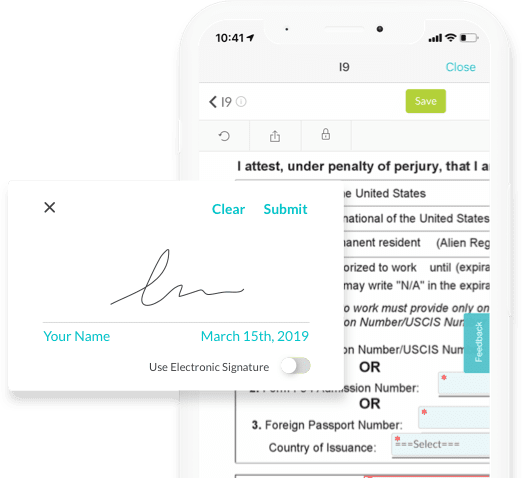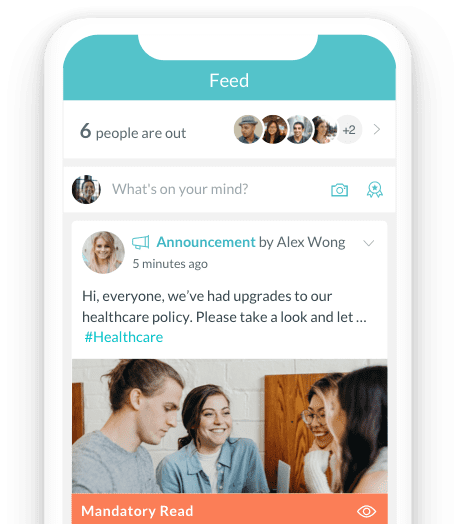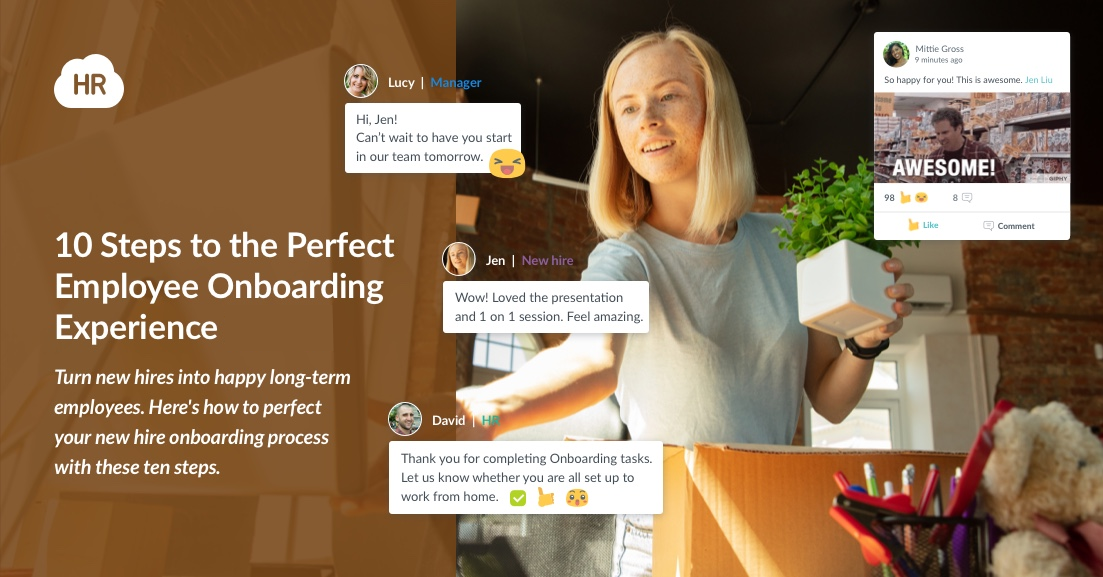- 1. Make Contact Before Day One
- 2. Make Their First Day Great
- 3. Provide Structure
- 4. Assemble a Team for the Process
- 5. Take It Easy on the Paperwork
- 6. Onboarding Programs Are a Team Effort
- 7. Establish Goals From the Start
- 8. Maintain an Open Dialogue
- 9. Share Your Company Culture
- 10. Give New Hires Time to Adjust
- Why Great New Hire Onboarding Matters
- Hire New Staff, and Keep Them Around!
- From Start to Finish—Your Partner in HR
Onboarding employees is a vital part of any company’s hiring process. It sets the tone for what your new employee can expect and helps them feel comfortable with their decision to join your team.
Converting a new hire into an engaged and productive employee is no small feat. Whether you offer an effective onboarding process can make or break their engagement, productivity, and your company’s culture for years to come. It’s worth the investment in time to get it right.
Accordingly, you may want to take advantage of online employee onboarding to make sure that the process goes smoothly. A web-based employee onboarding system can make sure that you don’t miss any important points.
Employers need to provide new hires with a good start. The perfect employee onboarding systems welcome new employees with open arms. What’s more, it provides them with the resources they need to succeed.
To learn ten steps to the perfect new hire onboarding experience, keep reading.
1. Make Contact Before Day One
Nearly a third of onboarding new hires decide to jump ship or stick around within the first 90 days of employment. With this in mind, it’s important not to throw your new hires to the wolves. In doing so, you’re sending the wrong message. With an official job offer, you can set the right tone from the start.
Something as simple as an offer letter or first-day welcome email can go a long way toward making a new hire feel valued. Alternatively, a comprehensive electronic onboarding may do the trick. Whatever method you use to introduce a new hire to your company, make sure to use it before their first day on the job.
2. Make Their First Day Great
Most new hires want to meet their manager on their first day on the job. They also expect to get introduced to their peers. These basic niceties set the right tone for long-term employment.
More often than not, someone will ask a new hire about their first day of work. This question is common.
However, the answer could mean the difference between a career staff member and someone who’s already thinking about the next employment opportunity. Accordingly, you want to make sure a staff member’s first day on the job goes smoothly. You can do so with the right employee onboarding tools.

3. Provide Structure
Strong HR onboarding software can greatly boost employee retention. It can also significantly impact productivity in a positive way. For instance, you might clearly list a new employee’s roles and responsibilities in your employee onboarding software.
It’s also helpful to schedule a new hire’s first week on the job a week or two ahead of time. The worst feeling for a new hire is not knowing what they should do next. With software onboarding, you can make sure that your new hires are always on task.
Moreover, a highly structured first couple of weeks gives new hires the right impression. It shows new hires nonverbally that you know what you’re doing. For example, you can schedule and track meetings using an employee onboarding website.
4. Assemble a Team for the Process
The amount of support provided by managers during the first two years of employment affects employee sentiment greatly. During this time, employees are clarifying their role with the company.
At the same time, they’re evaluating how they feel about the job. They’re even weighing whether their salary adequately compensates them for their work.
The best way to help your new hire maximize their potential is by assembling a team. The team will provide support and encouragement. You can coordinate the team with a new hire onboarding portal.
Firstly, you’ll need a coach who can take on the role of mentor or advisor. You’ll also want someone else with experience in the position they’ve accepted.
Your new hire will benefit greatly from their expertise when needed. What’s more, they can reach out to team members easily using your new hire onboarding software.
5. Take It Easy on the Paperwork
More often than not, new hires spend their first day at a desk or in a conference room completing paperwork. There are tons of forms to complete, including I-9’s, employee handbook acknowledgments and payroll forms.
Some jobs also require the reading and signing of lengthy nondisclosure agreements. As a result, the first day of work is typically associated with a massive amount of paperwork. However, you can use digital employee onboarding solutions to ease this burden.
There’s a drawback to dropping a load of paper on your new hire the first day on the job. A ton of paperwork on day one can make a new hire feel disenchanted or overwhelmed.
Alternatively, it’s better to spread paperwork out with HR onboarding solutions. Here, you want to afford your new hire flexibility to complete paperwork in a timely manner but at their leisure.
For instance, with the electronic onboarding of new employees, you can allow employees to check all the boxes at their own pace. You may even think about making use of an employee onboarding app.
6. Onboarding Programs Are a Team Effort
In a new workplace, it’s important to feel socially accepted. A feeling of social acceptance is a key factor in the success of new employees. With an HR onboarding solution, you can make sure that your new hires stay connected.
It’s important that a new employee integrates into a company social network. In part, this kind of engagement provides new hires with access to important information and resources.
It takes an entire company to integrate a new hire and get them up to speed.
Here, you want to schedule face time with new hires and veteran employees. You’ll want to have them meet with experienced staff members from every relevant department in their first few weeks.
Part of these meetings may include job shadowing when appropriate. You can schedule these activities with an electronic onboarding platform. You can also make use of employee communication tools that work just like social media.
“Our hiring managers now have a reliable system that is easy to navigate. Our HR team can actively monitor the process, and assist if needed, but Onboard has helped them save so much valuable time and effort while increasing data accuracy. All of this has helped us improve compliance and gives us a powerful tool to achieve even more results in the future.”

7. Establish Goals From the Start
Most employees will stay with a company for three or more years when they have a great onboarding experience. Vagueness is the enemy of a great new employee experience.
New hires need realistic and defined expectations. What’s more, they need these expectations communicated to them clearly.
With a thorough understanding of their roles, new hires can effectively evaluate their own progress. More importantly, they can prepare for a future with your company. The right onboarding software can help your new hires keep their careers on track.
8. Maintain an Open Dialogue
Nearly half of all workers feel put off when their superiors dismiss their ideas. After getting put on the back burner, most new hires will put forth the effort to share their ideas in the future.
You want your employees active and committed. Actively listening to and responding to employees is a great way to boost employee engagement.
Moreover, it’s vital to leave a channel open for honest, open feedback. By doing so, staff members are more likely to provide you with solutions to problems.
In some cases, they may shine a light on a problem that you didn’t even know existed. Top-notch onboarding software solutions can help you maintain an open line with your new hires.
9. Share Your Company Culture
Rating systems are becoming the norm for everything—including employee satisfaction. As company reviews become more common, HR professionals are noticing that the higher a company’s rating, the more likely new employees are to stay on the job.
Most new hires don’t fail because they don’t know how to do their work. More often than not, their personalities don’t mesh with the company work environment.
Ideally, you don’t want to hire new employees who are a poor cultural fit. Accordingly, you might assess employees in this regard. Even so, you’ll want to actively communicate and emphasized your organizational culture to promote the success of new hires.

10. Give New Hires Time to Adjust
Often, both employees and managers look forward to a scenario where the new hire “hits the ground running.” This phrase gets thrown around a lot and career circles. In reality, however, most employees take about eight months to reach their full potential.
Unfortunately, most employees who try to start out as company rock stars end up failing miserably. Any employer wants their staff members to start producing results as soon as possible.
However, putting too much pressure on employees too soon can prove detrimental to their development. Even worse, it can harm employee retention.
Why Great New Hire Onboarding Matters
As of July 2020, there were 5.8 million new hires in the United States. During the same time, 5 million of them quit, were discharged or got laid off.
On a brighter note, these numbers show that the job market persevered throughout the pandemic. However, this amount of turnover is abysmal.
It can cost more than $6,000 to hire a new employee. As a result, it’s important to onboard new hires attentively.
Hire New Staff, and Keep Them Around!
Despite a new hire’s skill set, it’s important to teach them what they need to know to do their jobs. It’s also important to build trust during the employee onboarding process.
Employees leave new jobs for many reasons. Some employees feel unsatisfied with their managers. Others may feel unhappy with their salaries.
Yet other employees may feel unsatisfied with their career outlook or benefits. In many cases, however, you can avoid this kind of sentiment by setting up new hires to succeed.
There are a lot of steps involved in the onboarding process. With the right technology, however, you can keep it all in sync easily.
From Start to Finish—Your Partner in HR
Now that you’ve learned ten steps to the perfect new hire onboarding experience, all you need is the best onboarding software.
HR Cloud is the most powerful employee management automation software on the market. Our goal is to help organizations manage human resource tasks more efficiently and productively. We’re committed to making your life easier by automating all of your HR tasks and providing you with a single, easy-to-use system that will save you time and money.
HR Cloud develops end-to-end onboarding systems for new employees. Our technology also allows you to nurture high-performing employees throughout their time at your company.
With HR Cloud, your HR team can easily manage every aspect of the job, including payroll, vacation requests, benefits enrollment, salary reviews and much more.
Don’t wait. Start on the path to improving employee engagement today by claiming your free HR Cloud trial.
About Author: This article is written by a marketing team member at HR Cloud. HR Cloud is a leading provider of proven HR solutions, including recruiting, onboarding, employee communications & engagement, and rewards & recognition. Our user-friendly software increases employee productivity, delivers time and cost savings, and minimizes compliance risk.
Keep Reading
Retention Reset: How to Keep Your Best Talent in 2025
More employees are walking away from their jobs in 2025 not just for better pay, but for
Remote Onboarding Done Right: A Step-by-Step Guide for HR Teams
Remote onboarding is the process of welcoming new employees who work from home or



